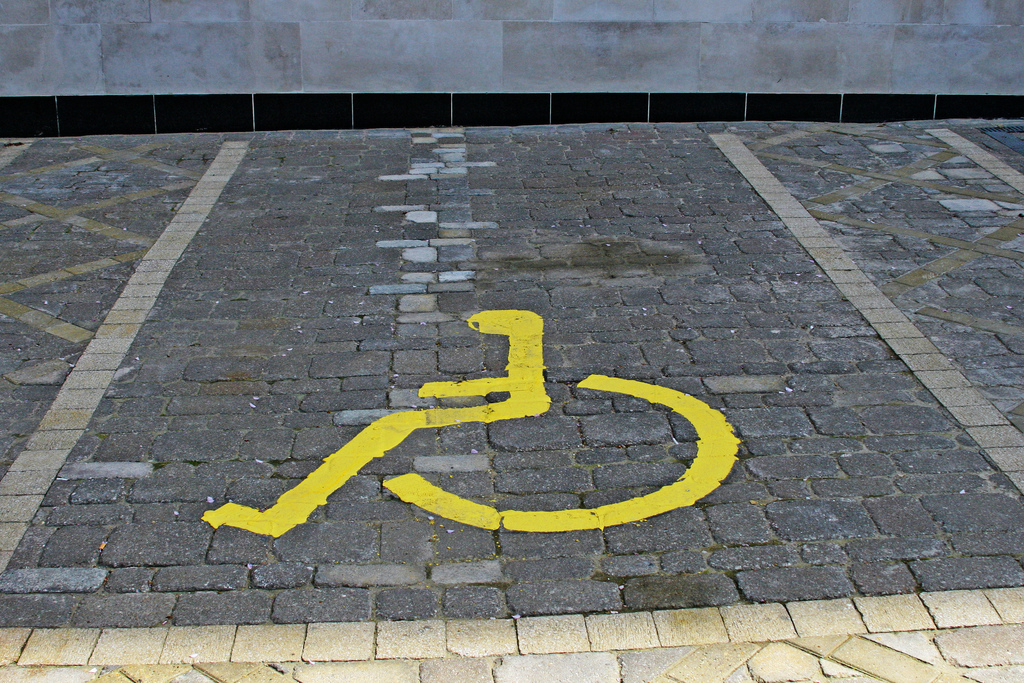Accessibility for the disabled in the Netherlands – how is it?
When most of us dream of Europe, we think about the historic buildings, the beautiful cobblestone streets, the people getting from point A to B on bicycles or Vespas, and the laid-back nature of the people. Holland has this kind of charm in spades and is a huge part of the reason we get visited by nearly 16 million tourists each year.
However, this old-world charm isn’t so charming if you have a disability, especially one that makes walking difficult like I do. When I first arrived in Holland, I was taken aback by the lack of universal accessibility as is seen in the United States. Back home, the Americans with Disabilities Act (ADA) ensures disability access to all public spaces and businesses constructed or opened after 1990. Accessibility in the Netherlands is not what I expected.
As you can imagine, it would be more than just a little challenging to require such accommodations in a city that is hundreds of years old, after all, there were no wheelchairs in Rembrandt’s days! Back then, if you had a disability, you were, as we say in America, S-O-L (s#%t out of luck). Much of the center of Amsterdam, in particular, is protected under UNESCO Heritage Site rules, making modernization nearly impossible. Thus, most buildings today still have those Golden Age staircases (which many people without a disability have trouble with at times), and building occupants must keep preservation in mind when working on a public space.
The law
So, all of this begs the question: if you are one of the thousands of visitors to Holland with a disability, is a visit here more trouble than it’s worth? I wanted to find out, so I reached out to a disability travel expert, Veroniek Maat of Accessible Travel Netherlands, to find out.
The good news is that there are laws on the books that help ensure disability rights. In 2016, the Netherlands ratified the UN Convention on the Rights for People with Disabilities, meant to encourage, protect, and ensure the rights of people with disabilities. The bad news is that those laws are frequently violated with impunity. Those vehicles parked on sidewalks: violation. The tram official refusing to help you get in with your wheelchair or telling you to use the far exit when you clearly have a disability: violation. Those restaurants that could add a wheelchair ramp in the front and don’t or don’t have wheelchair-accessible tables: violation.

Despite some difficulties, Veroniek ensured me that it’s still possible to have an amazing time in Holland, even with mobility issues. Here are some tips she shared, and which I then tested for myself.
1. Research Public Transportation Options
It’s important to know how to get from point to point, so researching tram and bus schedules and arranging private transfers are key. Since your route will require the least amount of walking possible, plan to take longer routes that involve more time in a vehicle and less time on the sidewalk. For getting to places with little or no public transport option (like going to visit a farm or seeing the tulips), be prepared to work with taxis to take you that extra distance. You’ll want to likely avoid using a rideshare like Uber since those are less predictable than taxis.
Several months ago, I visited the town of Veenendaal for a pinball tournament. When I arrived at the train station (more like a little depot) I tried finding an Uber to my hotel, which was about a kilometer away. Nothing was available. I then tried calling the nearest taxi company, and they said “your hotel is just a few minutes’ walk away.” When I explained I couldn’t walk that far and even if I could it would take me about an hour, he agreed to pick me up. You’re playing with fire if you plan to visit a new place but don’t pre-plan transportation.

2. Plan Attractions and Restaurants Ahead of Time
For reasons I’ve already discussed, it’s nearly impossible to predict ahead of time which attractions, accommodations, and restaurants will be accessible, so it’s worth doing some research ahead of time to help avoid frustration. Accessible Travel has put together a great planning guide for Amsterdam and surrounding areas(pdf), with accessible routes around the city, as well as a long list of restaurants, museums, shopping areas, photo opportunities, and other attractions that will ensure a fulfilling and enjoyable experience.
I’ve experienced my own frustrations when I first arrived in Holland, so I can relate to the multitude of tourists who discover that they can sit and eat in a popular restaurant, just to realize the restroom is located in the basement, down a staircase that looks more like a ladder. I can feel empathy for the weary disabled traveler who wants to visit the most famous house in Amsterdam, the Anne Frank House, just to realize that the house, understandably, has no accessibility modifications (though the new building housing the current exhibition, the café, and the gift shop is fully accessible and still worth a visit).
When in doubt about what accessibility options exist at a particular business, it’s best to call ahead to find out what accommodations are available.

3. Travel with a Buddy or Guide
Traveling alone can be a nerve-racking endeavor for fully-abled individuals, but for those who have difficulty getting around, traveling can be downright overwhelming. Sharing the responsibility for planning and undertaking an accessible trip can take an emotional load off the disabled traveler. Traveling with a friend who “has your back” or with a local expert will make for a much smoother and enjoyable trip. Not to mention it’s useful to have someone who can advocate on your behalf, walk ahead to scope out the situation at a restaurant, and be an extra set of eyes in pickpocket-filled areas. No friend with whom to travel? Talk to a tour company like Accessible Travel Netherlands to be your friends during your travels.
I’m lucky to get to travel with my wife wherever I go, and besides the obvious joy of traveling with a spouse, my wife helps make our travels as smooth as possible. She jumps ahead at airports to get assistance, helps make sure I remain upright when traversing over cobblestone streets, and does the yelling for me when someone is behaving boorishly towards me. She’s quite a woman!

4. Speak Up!
When you go out and need accommodation at a restaurant or other venue, make sure the people assisting you know you have special needs. You don’t need to say much about your condition, and they’ll likely notice that you have mobility issues if they’re paying attention at all. I don’t use a wheelchair, so I carry around my disability parking pass from the US, and flashing it when I need accommodations is typically enough for staff to spring into action. It’s been my experience that the Dutch are usually good at being helpful when you present them with this particular problem.
We all know about the Dutch directness when it comes to telling you what they think: you are never left wondering! This directness often comes off as “this is my answer and that’s that,” but I just see it as an opportunity to practice my negotiation skills. Never take the first answer you get from a Dutch person. “Sorry, we don’t have any accessible tables” can turn into “We’ll move some things around and we’ll make room for you” if you keep at it.

5. Expect the Unexpected
No matter how much you plan, no matter how much you try to anticipate roadblocks, you will invariably run into issues on your trip. With everything from blocked sidewalks where you are forced to get through by walking in the bike lane, to rude Dutchies who will directly ask you “what’s wrong with you,” to finding stairs in unexpected places (like right before an elevator), to avoiding collision with a bicycle, you should expect the unexpected.
As people with disabilities, we’re used to problem-solving in the face of roadblocks. This skill will be critical when visiting Holland. Just keep in mind that the people here are generally good, and they’re willing to help if you ask. Keep your composure, and know that with a little planning and the occasional stern look, you can have a fantastic time visiting Holland, no matter your abilities.
So, there you have it! 5 tips on accessibility for the disabled in the Netherlands. Do you have anything more to add about accessibility for the disabled in the Netherlands? Let us know in the comments.



I find it rather ironic that the author uses his U.S. pass in Holland .When I visit the U.S. ,I have my disability card on the dash of my car ,I get dirty looks or comments because I don’t have the disability license plate which we don’t have in Canada when parking in a spot marked for the disabled.
Schiphol is the WORST experience. Dutch flight attendants and other staff were rude and unhelpful. They have no sensitivity training. The airport itself left myself and other disabled folk on my flight stranded for several hours. They had no available equipment to board us. That there was only one vehicle for the entire international airport was inconceivable. I have Multiple Sclerosis (MS), (my meds have helped gain weight). Being overweight is a flashpoint for ridicule apparently. WHEELCHAIR people were repeatedly asked if they could not manage a few steps to get on the plane! From tarmac to the planes door is 25 steps for sure. Heaven forbid that we disabled people inconvenience anyone! Holland is beautiful but the people need an attitude adjustment!
P.S. I am not morbidly obese but I’m 5’10 and 240 lbs, a good sized football players weight.
Hello: I enjoyed reading your article. I use a walking device to walk greater distances but can do some walking of my own being really careful because I can fall easily due to weakness in my legs and arms. Flat surfaces are my best bet but I know that is not guaranteed. I have dreamed of visiting The Netherlands and your article made me feel comfortable enough to start thinking about it. Thanks for reaching out to those of us who need this information. I am really grateful and look forward to visit very soon and have a great experience.